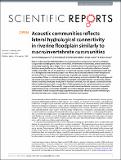Files in this item
Acoustic communities reflects lateral hydrological connectivity in riverine floodplain similarly to macroinvertebrate communities
Item metadata
| dc.contributor.author | Desjonquères, Camille | |
| dc.contributor.author | Rybak, Fanny | |
| dc.contributor.author | Castella, Emmanuel | |
| dc.contributor.author | Llusia, Diego | |
| dc.contributor.author | Sueur, Jérôme | |
| dc.date.accessioned | 2021-03-11T16:30:02Z | |
| dc.date.available | 2021-03-11T16:30:02Z | |
| dc.date.issued | 2018-09-26 | |
| dc.identifier | 272934044 | |
| dc.identifier | fe25130b-c50c-4b1b-81a2-ead01dc87f85 | |
| dc.identifier | 85054067971 | |
| dc.identifier | 30258085 | |
| dc.identifier.citation | Desjonquères , C , Rybak , F , Castella , E , Llusia , D & Sueur , J 2018 , ' Acoustic communities reflects lateral hydrological connectivity in riverine floodplain similarly to macroinvertebrate communities ' , Scientific Reports , vol. 8 , 14387 . https://doi.org/10.1038/s41598-018-31798-4 | en |
| dc.identifier.issn | 2045-2322 | |
| dc.identifier.other | ORCID: /0000-0002-6150-3264/work/89178818 | |
| dc.identifier.uri | https://hdl.handle.net/10023/21618 | |
| dc.description | Funding: This project was supported by a fieldwork grant from the LabEx BCDiv, an ENS PhD grant (CD), and a Post-doctoral grant from the Fondation Fyssen (DL). Acquisition of community data was partly funded by the scientific monitoring of the Rhone River restoration funded by the “Compagnie Nationale du Rhône”, “Agence de l’Eau Rhône-Méditerranée-Corse” and “Région Rhône-Alpes”. | en |
| dc.description.abstract | Recent studies revealed that information on ecological patterns and processes can be investigated using sounds emanating from animal communities. In freshwater environments, animal communities are strongly shaped by key ecological factors such as lateral connectivity and temperature. We predict that those ecological factors are linked to acoustic communities formed by the collection of sounds emitted underwater. To test this prediction, we deployed a passive acoustic monitoring during 15 days in six floodplain channels of the European river Rhône. The six channels differed in their temperature and level of lateral connectivity to the main river. In parallel, we assessed the macroinvertebrate communities of these six channels using classical net sampling methods. A total of 128 sound types and 142 animal taxa were inventoried revealing an important underwater diversity. This diversity, instead of being randomly distributed among the six floodplain channels, was site-specific. Generalized mixed-effects models demonstrated a strong effect of both temperature and lateral connectivity on acoustic community composition. These results, congruent with macroinvertebrate community composition, suggest that acoustic communities reflect the interactions between animal communities and their environment. Overall our study strongly supports the perspectives offered by acoustic monitoring to describe and understand ecological patterns in freshwater environments. | |
| dc.format.extent | 11 | |
| dc.format.extent | 2220065 | |
| dc.language.iso | eng | |
| dc.relation.ispartof | Scientific Reports | en |
| dc.subject | QH301 Biology | en |
| dc.subject | DAS | en |
| dc.subject.lcc | QH301 | en |
| dc.title | Acoustic communities reflects lateral hydrological connectivity in riverine floodplain similarly to macroinvertebrate communities | en |
| dc.type | Journal article | en |
| dc.contributor.institution | University of St Andrews. School of Biology | en |
| dc.identifier.doi | 10.1038/s41598-018-31798-4 | |
| dc.description.status | Peer reviewed | en |
This item appears in the following Collection(s)
Items in the St Andrews Research Repository are protected by copyright, with all rights reserved, unless otherwise indicated.

